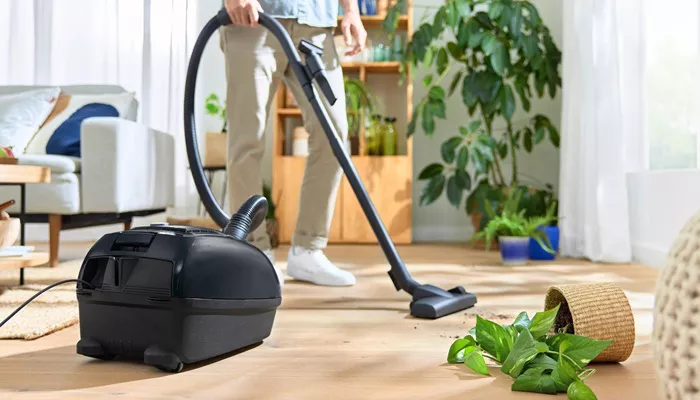Bagged vacuum cleaners are traditional cleaning devices that use disposable bags to collect dirt, dust, and debris. These bags are replaced when full, offering a hygienic and convenient cleaning solution. In this article, we will explore the features, benefits, drawbacks, and ideal use cases of bagged vacuum cleaners, providing you with a comprehensive understanding to help you decide if they are the right choice for your cleaning needs.
Understanding The Bagged Vacuum Cleaners
Bagged vacuum cleaners have been a staple in households for decades. Their design involves a replaceable bag that traps dust and debris, preventing them from being released back into the air. This feature makes them particularly appealing to individuals with allergies or respiratory sensitivities.
How Bagged Vacuum Cleaners Work
When you operate a bagged vacuum cleaner, air is drawn into the machine through the nozzle. This air passes through filters and into the disposable bag, where dirt and debris are trapped. The filtered air then exits the vacuum, leaving your home cleaner and the air fresher.
Advantages of Bagged Vacuum Cleaners
1. Superior Filtration and Hygiene
Bagged vacuums often come equipped with high-quality filters, such as HEPA filters, that capture fine particles, including dust, pollen, and pet dander. This makes them an excellent choice for individuals with allergies or asthma. The sealed bags also prevent dust from escaping during disposal, maintaining a cleaner environment.
2. Less Frequent Maintenance
Since the dirt is contained within the bag, there is less need to clean the vacuum’s internal components. This reduces maintenance time and effort, allowing you to focus more on cleaning your home.
3. Larger Dirt Capacity
Bagged vacuums typically have larger dirt capacities compared to their bagless counterparts. This means you can clean more area before needing to replace the bag, making them suitable for larger homes or spaces with heavy foot traffic.
4. Reduced Exposure to Allergens
When it’s time to replace the bag, you can do so without coming into contact with the collected dirt and dust. This feature is particularly beneficial for allergy sufferers, as it minimizes exposure to potential allergens.
Disadvantages of Bagged Vacuum Cleaners
1. Ongoing Cost of Replacement Bags
One of the main drawbacks of bagged vacuum cleaners is the recurring cost of purchasing replacement bags. Depending on usage, these costs can add up over time, especially if you have a large area to clean regularly.
2. Potential Decrease in Suction Power
As the bag fills up, the vacuum’s suction power may decrease. It’s important to replace the bag promptly to maintain optimal performance. Some models may have indicators to alert you when the bag is full.
3. Environmental Impact
Disposable bags contribute to environmental waste. While some manufacturers offer recyclable bags, the overall environmental impact remains a consideration for eco-conscious consumers.
Ideal Use Cases for Bagged Vacuum Cleaners
1. Allergy and Asthma Sufferers
Due to their superior filtration systems and sealed bags, bagged vacuums are ideal for individuals with allergies or asthma. They help trap allergens effectively, reducing symptoms triggered by dust and other particles.
2. Large Homes or High-Traffic Areas
The larger dirt capacity of bagged vacuums makes them suitable for cleaning expansive areas or spaces with heavy foot traffic. You can clean more before needing to replace the bag, improving efficiency.
3. Environments Requiring High Hygiene Standards
In settings where cleanliness is paramount, such as healthcare facilities or food preparation areas, bagged vacuums offer a hygienic solution by containing dirt and dust securely within the bag.
Comparison: Bagged vs. Bagless Vacuum Cleaners
When choosing between bagged and bagless vacuum cleaners, it’s essential to consider your specific needs and preferences. Here’s a brief comparison:
| Feature | Bagged Vacuum Cleaners | Bagless Vacuum Cleaners |
|---|---|---|
| Filtration | Often equipped with HEPA filters | Varies; may require frequent filter cleaning |
| Maintenance | Less frequent; mainly involves bag replacement | More frequent; requires cleaning of dustbin and filters |
| Cost | Initial cost plus ongoing cost of replacement bags | Initial cost; no recurring cost for bags |
| Environmental Impact | Contributes to waste due to disposable bags | Less waste; dustbin can be emptied and reused |
Top Brands Offering Bagged Vacuum Cleaners
Several reputable brands offer high-quality bagged vacuum cleaners. Some of the top brands include:
- SEBO: Known for durable and efficient bagged vacuums suitable for both home and commercial use.
- Miele: Offers premium bagged models with advanced filtration systems and ergonomic designs.
- Kenmore: Provides a range of bagged vacuums known for their reliability and performance.
Conclusion
Bagged vacuum cleaners offer a hygienic, low-maintenance, and efficient cleaning solution, particularly beneficial for allergy sufferers and those with larger homes. While they come with ongoing costs for replacement bags and contribute to environmental waste, their advantages in filtration and ease of use make them a popular choice for many consumers. Consider your specific cleaning needs and preferences when choosing between bagged and bagless vacuum cleaners to find the best fit for your home.
Related topics:
- What is the Smallest Robot Vacuum?
- The 12 Most Popular Vacuum Cleaners of 2025
- Is Electrolux a Good Vacuum?

